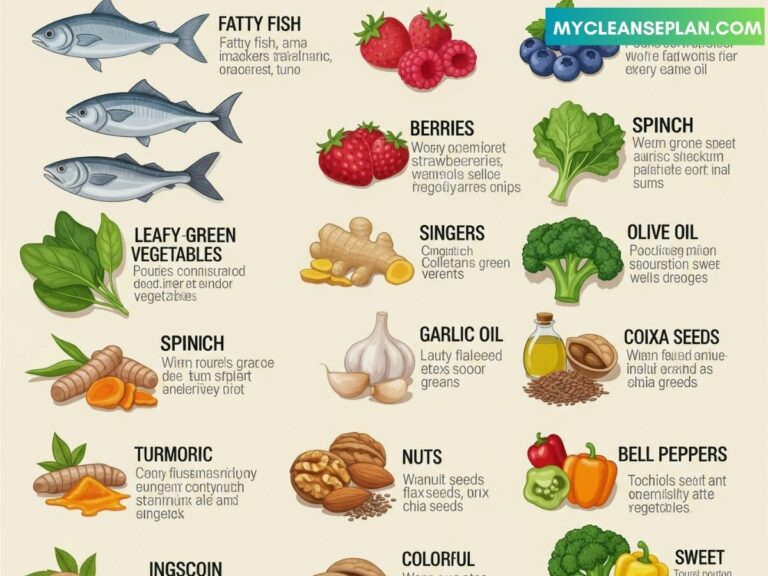What Is an Anti-Inflammatory Diet?
Chronic inflammation is a growing concern, linked to various health issues. I’ve come to realize that adopting an eating plan that focuses on reducing inflammation can be a game-changer.
This approach emphasizes consuming foods that help mitigate or eliminate inflammation in the body.
By incorporating the right foods into your meal plan, you can potentially improve your overall well-being. This diet is centered around whole, nutrient-rich foods that are known to combat inflammation.
Key Takeaways

What Is an Anti-Inflammatory Diet? Understanding the Basics
The concept of an anti-inflammatory diet is rooted in the science of inflammation and its impact on overall health.
An anti-inflammatory diet is designed to help manage and reduce chronic inflammation, which is associated with various health conditions.

By understanding how inflammation works in the body and the differences between acute and chronic inflammation, individuals can make informed dietary choices to improve their health.
The Science of Inflammation in the Body
Inflammation is the body’s natural response to injury or infection. It’s a complex process involving various cellular and chemical reactions.
When the body detects harm, it initiates an inflammatory response to protect itself, repair damaged tissue, and fight off infections.

Acute vs. Chronic Inflammation
Acute inflammation is a short-term response that typically resolves once the underlying cause is addressed.
In contrast, chronic inflammation persists over time and can lead to various health issues, including cardiovascular disease, diabetes, and arthritis.
Diet plays a significant role in managing chronic inflammation. Consuming foods that trigger or exacerbate inflammation can worsen the condition, while an anti-inflammatory diet can help mitigate it.
Understanding the difference between acute and chronic inflammation is crucial for appreciating the importance of an anti-inflammatory diet.
| Type of Inflammation | Duration | Effects on the Body |
|---|---|---|
| Acute Inflammation | Short-term | Protects the body, repairs damaged tissue |
| Chronic Inflammation | Long-term | Can lead to various health issues, including cardiovascular disease and arthritis |
The Connection Between Chronic Inflammation and Disease
Understanding the link between chronic inflammation and disease is crucial for maintaining overall health. Chronic inflammation can lead to various health issues, affecting different parts of the body.
Common Inflammatory Conditions
Several diseases are associated with chronic inflammation. These include:
Arthritis and Joint Pain
Arthritis is a condition characterized by joint inflammation, leading to pain and stiffness. It can significantly impact one’s quality of life.
Cardiovascular Disease
Chronic inflammation is also linked to cardiovascular disease, where it can contribute to the development of plaque in arteries, potentially leading to heart attacks or strokes.
Digestive Disorders
Inflammatory bowel diseases like Crohn’s disease and ulcerative colitis are examples of chronic inflammation affecting the digestive tract.
| Disease | Inflammatory Impact | Potential Consequences |
|---|---|---|
| Arthritis | Joint inflammation | Pain, stiffness, reduced mobility |
| Cardiovascular Disease | Artery inflammation | Heart attack, stroke |
| Digestive Disorders | Digestive tract inflammation | Diarrhea, abdominal pain, weight loss |
How Food Choices Trigger or Reduce Inflammation
Food plays a significant role in either triggering or reducing inflammation. Diets high in processed foods and sugars can exacerbate inflammation, while consuming anti-inflammatory foods like omega-3 rich fish, fruits, and vegetables can help reduce it.

By making informed food choices, individuals can potentially mitigate the risk or severity of inflammatory conditions. Incorporating anti-inflammatory foods into one’s diet is a proactive step towards better health.
Key Benefits of an Anti-Inflammatory Diet
Adopting an anti-inflammatory diet can have a significant impact on overall health, leading to numerous benefits. By focusing on the consumption of anti-inflammatory foods, individuals can potentially reduce the risk of chronic diseases and improve their quality of life.
Reduced Pain and Discomfort
One of the primary benefits of an anti-inflammatory diet is the reduction in pain and discomfort associated with inflammatory conditions.
Foods rich in omega-3 fatty acids, such as salmon, and antioxidants, found in berries and leafy greens, can help alleviate symptoms of arthritis and other inflammatory diseases.
Improved Heart Health
An anti-inflammatory diet can also contribute to improved heart health by reducing the intake of pro-inflammatory foods and increasing the consumption of heart-healthy foods like olive oil and nuts. This dietary approach can help lower the risk of cardiovascular disease.
Enhanced Brain Function and Mood
The diet’s impact on brain health is another significant benefit, with certain foods potentially enhancing cognitive function and mood. Foods high in antioxidants and omega-3 fatty acids are known to support brain health.
Weight Management and Metabolic Health
Furthermore, an anti-inflammatory diet can aid in weight management and improve metabolic health. By focusing on whole, nutrient-dense foods, individuals can achieve a healthier weight and reduce the risk of metabolic syndrome.

By incorporating the best anti-inflammatory foods into your diet, you can experience these benefits firsthand. It’s about making informed choices that support your overall health and well-being.
Foods to Embrace on an Anti-Inflammatory Diet
When it comes to reducing inflammation, the food you eat plays a crucial role, and I’m here to guide you through the best choices.
An anti-inflammatory diet plan focuses on incorporating foods that are rich in antioxidants, fiber, and healthy fats.

Colorful Fruits and Vegetables
Colorful fruits and vegetables are packed with antioxidants and polyphenols that help combat inflammation. Including a variety of colors on your plate ensures you get a range of nutrients.
Berries and Antioxidant-Rich Fruits
Berries such as blueberries, strawberries, and raspberries are rich in antioxidants and have been shown to have anti-inflammatory effects. Other antioxidant-rich fruits include pomegranates and citrus fruits.
Leafy Greens and Cruciferous Vegetables
Leafy greens like spinach and kale, along with cruciferous vegetables such as broccoli and cauliflower, contain sulforaphane, which has potent anti-inflammatory properties.
Healthy Fats and Omega-3 Sources
Healthy fats, particularly omega-3 fatty acids found in fatty fish like salmon and sardines, are crucial for reducing inflammation. Other sources include flaxseeds and walnuts.
Nuts, Seeds, and Legumes
Nuts and seeds, such as almonds and chia seeds, are rich in healthy fats and antioxidants. Legumes, including lentils and chickpeas, are high in fiber and protein, making them excellent choices for an anti-inflammatory diet.
Anti-Inflammatory Herbs and Spices
Certain herbs and spices have anti-inflammatory properties. Turmeric, with its active compound curcumin, ginger, and cinnamon are examples of spices that can help reduce inflammation.
By incorporating these foods into your diet, you can take a significant step towards reducing inflammation and improving your overall health. Starting an anti-inflammatory diet plan involves making informed choices about the foods you eat daily.
Foods to Limit or Avoid
To reap the anti-inflammatory diet benefits, it’s crucial to identify and limit foods that can cause inflammation.
While incorporating anti-inflammatory foods into your diet is vital, it’s equally important to be aware of the foods that can trigger or worsen inflammation.

Certain foods can negate the positive effects of an anti-inflammatory diet, so understanding what to limit or avoid is key to achieving the importance of an anti-inflammatory diet.
Processed Foods and Added Sugars
Processed foods and those with added sugars are among the top foods to limit. They often contain unhealthy fats, sodium, and other pro-inflammatory ingredients that can trigger inflammation.
Refined Carbohydrates and Gluten Considerations
Refined carbohydrates, such as white bread and sugary snacks, can cause a spike in blood sugar and insulin resistance, leading to inflammation. For individuals with gluten intolerance or sensitivity, consuming gluten can also lead to an inflammatory response.
Inflammatory Oils and Trans Fats
Oils high in omega-6 fatty acids, when consumed in excess, can promote inflammation. Similarly, trans fats found in processed and fried foods are known to trigger inflammatory processes in the body.
Alcohol, Caffeine, and Other Beverages
While moderate alcohol consumption may have some health benefits, excessive intake can lead to inflammation. Caffeine, when consumed in large amounts, can also have pro-inflammatory effects in some individuals. Other beverages, such as those with high sugar content, should also be limited.
Creating Your Anti-Inflammatory Meal Plan
An anti-inflammatory diet plan is not just about cutting out certain foods, it’s about embracing a new way of eating that nourishes your body.
As we discussed earlier, the right foods can play a crucial role in reducing inflammation. Now, let’s dive into how you can create a personalized meal plan that works for you.
Sample 7-Day Anti-Inflammatory Diet Plan
To get you started, here’s a sample 7-day meal plan that incorporates anti-inflammatory foods. This plan is designed to be flexible, so feel free to swap out ingredients based on your preferences and dietary needs.
Breakfast Options
- Oatmeal with Berries and Nuts: Steel-cut oats cooked with almond milk, topped with fresh berries and chopped walnuts.
- Avocado Toast: Whole-grain toast topped with mashed avocado, a fried egg, and a sprinkle of turmeric.
- Green Smoothie: Blend of spinach, banana, almond milk, and chia seeds.
Lunch and Dinner Ideas
- Grilled Salmon with Roasted Vegetables: Salmon fillet grilled to perfection, served with a variety of roasted vegetables such as Brussels sprouts and sweet potatoes.
- Quinoa Salad Bowl: Mixed quinoa with chopped vegetables, nuts, and a citrus vinaigrette dressing.
- Lentil Soup: Hearty soup made with red or green lentils, vegetables, and aromatic spices.
Snacks and Desserts
- Fresh Fruit Salad: A mix of seasonal fruits such as berries, citrus, and apples.
- Dark Chocolate Square: A small piece of dark chocolate (at least 70% cocoa) enjoyed mindfully.
- Herbal Tea: Soothing teas like peppermint, chamomile, or ginger tea.

Meal Prep Strategies for Success
To make your anti-inflammatory diet a success, consider meal prepping. This can involve cooking large batches of a single ingredient, like brown rice or lentils, and using them throughout the week in different meals.
Planning your meals around seasonal produce can also help ensure you’re getting a variety of anti-inflammatory foods.
“The food you eat can either be the safest and most powerful form of medicine or the slowest form of poison.” – Ann Wigmore
Anti-Inflammatory Recipes to Try
Experimenting with new recipes can keep your diet interesting and ensure you’re getting a wide range of nutrients.
Some anti-inflammatory recipes to try include turmeric-spiced cauliflower rice, ginger and garlic stir-fry, and salads featuring walnuts and berries.
Don’t be afraid to get creative and adjust recipes based on your taste preferences and dietary needs.
How to Transition to an Anti-Inflammatory Diet
Making the switch to an anti-inflammatory diet can be achieved by focusing on small, sustainable changes that add up over time.
This approach not only makes the transition smoother but also increases the likelihood of long-term adherence.
Starting with Small, Sustainable Changes
Begin by introducing more anti-inflammatory foods into your diet while gradually reducing the consumption of pro-inflammatory foods.
Start with simple swaps, such as replacing refined grains with whole grains and increasing your intake of fruits and vegetables.
I recommend keeping a food diary to track your eating habits and identify areas for improvement. This will help you stay on course and make informed decisions about your diet.
Shopping Tips for Anti-Inflammatory Foods
When shopping for anti-inflammatory foods, focus on whole, unprocessed foods as much as possible. Here are some tips to guide your shopping:
- Choose colorful fruits and vegetables, which are rich in antioxidants.
- Opt for fatty fish like salmon and sardines, which are high in omega-3 fatty acids.
- Select whole grains over refined grains.
- Nuts and seeds, such as walnuts and chia seeds, are great sources of healthy fats.
| Food Category | Anti-Inflammatory Options |
|---|---|
| Fruits | Berries, citrus fruits, apples |
| Vegetables | Leafy greens, broccoli, bell peppers |
| Protein Sources | Fatty fish, grass-fed beef, free-range chicken |
Dining Out While Following the Diet
Dining out can be challenging when following an anti-inflammatory diet, but it’s not impossible. Here are some strategies to help you stay on track:
When eating out, choose restaurants that offer fresh, whole foods. Opt for dishes that are rich in vegetables, lean proteins, and healthy fats. Don’t hesitate to ask for modifications to suit your dietary needs.

By starting with small changes, shopping smart, and being mindful of your choices when dining out, you can successfully transition to an anti-inflammatory diet and enjoy its numerous health benefits.
The Science Behind Anti-Inflammatory Eating
The science behind anti-inflammatory eating is rooted in a deep understanding of how certain foods impact our body’s inflammatory response. As research continues to evolve, it has become increasingly clear that dietary choices play a significant role in managing inflammation.

Current Research and Clinical Evidence
Recent studies have highlighted the importance of anti-inflammatory diets in reducing the risk of chronic diseases. Research has shown that certain foods, such as those rich in omega-3 fatty acids and antioxidants, can help mitigate inflammation.
For instance, a study published in the Journal of Nutrition found that a diet rich in fruits, vegetables, and whole grains can reduce inflammation in adults.
Some key findings from current research include:
- The role of omega-3 fatty acids in reducing inflammation
- The impact of antioxidants on oxidative stress
- The benefits of a diet rich in fiber on gut health
What Medical Professionals Recommend
Medical professionals increasingly recommend anti-inflammatory diets to patients at risk of chronic diseases. According to experts, incorporating anti-inflammatory foods into one’s diet can have a significant impact on overall health.
For example, the American Heart Association recommends a diet rich in fruits, vegetables, and whole grains to reduce the risk of heart disease.
Some common recommendations from medical professionals include:
- Increasing consumption of omega-3 rich foods
- Eating a variety of colorful fruits and vegetables
- Incorporating anti-inflammatory spices and herbs into meals
By understanding the science behind anti-inflammatory eating and following the recommendations of medical professionals, individuals can make informed choices about their diet and reduce their risk of chronic diseases.
FAQ Of What Is an Anti-Inflammatory Diet?
What are the primary benefits of following an anti-inflammatory diet?
The primary benefits include reduced pain and discomfort, improved heart health, enhanced brain function and mood, and better weight management and metabolic health.
How does an anti-inflammatory diet help with chronic inflammation?
By focusing on whole, nutrient-dense foods and avoiding pro-inflammatory foods, an anti-inflammatory diet can help reduce chronic inflammation, which is associated with various health conditions.
What foods should I eat on an anti-inflammatory diet?
Emphasize colorful fruits and vegetables, healthy fats and omega-3 sources, nuts, seeds, legumes, and anti-inflammatory herbs and spices, as these foods are rich in antioxidants and other nutrients that help combat inflammation.
Are there specific foods I should limit or avoid on an anti-inflammatory diet?
Yes, it’s best to limit or avoid processed foods, added sugars, refined carbohydrates, inflammatory oils, and certain beverages like alcohol and excessive caffeine, as they can trigger or worsen inflammation.
How do I start an anti-inflammatory diet?
Begin by making small, sustainable changes, such as incorporating more anti-inflammatory foods into your meals and gradually reducing your intake of pro-inflammatory foods.
Can an anti-inflammatory diet help with weight management?
Yes, by focusing on whole, nutrient-dense foods, an anti-inflammatory diet can support weight management and overall metabolic health.
Is an anti-inflammatory diet suitable for everyone?
While an anti-inflammatory diet can be beneficial for most people, it’s essential to consult with a healthcare professional, especially if you have specific dietary needs or restrictions.
How long does it take to see the benefits of an anti-inflammatory diet?
The timeframe for experiencing benefits can vary depending on individual circumstances, but many people report improvements within a few weeks to a few months of adopting an anti-inflammatory diet.
Conclusion: Embracing Anti-Inflammatory Living for Better Health
As we have explored throughout this article, adopting an anti-inflammatory diet is a crucial step towards achieving overall wellness.
By understanding What Is an Anti-Inflammatory Diet?, we can harness its potential to reduce chronic inflammation, a key factor in various diseases.
The importance of an anti-inflammatory diet lies in its ability to promote healthy eating habits, rich in fruits, vegetables, and omega-3 fatty acids, while minimizing processed foods and sugars. This dietary approach not only enhances physical health but also supports mental well-being.
By incorporating the principles outlined in this article, individuals can take a proactive approach to managing their health.
Embracing an anti-inflammatory lifestyle is a journey that requires commitment, but the benefits to overall health and quality of life make it a worthwhile endeavor.






